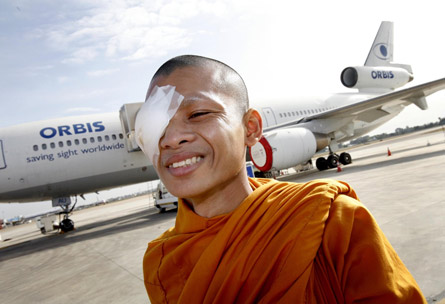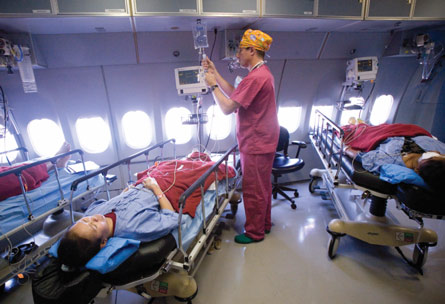The coming year will serve as a sort of long goodbye for Orbis International's current "Flying Eye Hospital".
Operated by the non-profit organisation since 1994, the 1970-built McDonnell Douglas DC-10-10 - which has a state-of-the-art surgical suite and teaching facility - is nearing the end of its projected lifespan and will be replaced by an MD-10 in early 2011.
But while retirement may be around the corner for the near 40-year-old ambassador of goodwill, it cannot rest its wings just yet.
In 2010 Orbis plans to operate 10 Flying Eye Hospital missions to impoverished areas around the world, including Niamey, Niger; Kampala, Uganda; Chengdu, China; Phnom Penh, Cambodia; and Surabaya, Indonesia.
On the ground, a dedicated medical team will carry out the work for which Orbis is now famous - providing crucial training, performing surgeries and restoring sight to children and adults.
"We have a cadre of almost 500 volunteers, an international group that work on our plane and provide hands-on training to the doctors, nurses and other healthcare personnel on how to do these eye surgeries," says Orbis director, corporate partnerships Liz Sheppard, noting that even the pilots, retired FedEx Express freight dogs, serve as volunteers.
But Orbis's efforts extend far beyond the Flying Eye Hospital. The charity has established permanent offices in five priority countries - Bangladesh, China, Ethiopia, India and Vietnam, and long-term efforts are under way in Latin America and the Caribbean.
 |
|---|
© Kristina Wentz-GraffBuddhist monk Bunthoeuom Song emerges from the Flying Eye Hospital after a corneal transplant that restored sight to his right eye |
"All of the Flying Eye Hospital missions are two-week programmes and all are connected to hospital-based programmes with our work on the ground," says Sheppard.
It is the type of broad-reaching effort that has a lasting - and measurable - impact.
The World Health Organisation has identified the fight against childhood blindness as one of the most cost-effective of all health interventions. "Some 90% of blind children in the developing world do not go to school. Blindness also severely impacts gross domestic product in developing countries," says Sheppard.
EYE SURGERIES
Since its first mission to Panama in 1982, Orbis has carried out 1,000 programmes across 87 countries. Some 234,000 eye-care professionals have been trained, and 517,000 eye surgeries performed. In all, about 9.7 million individuals have been medically treated as a result of Orbis's work.
Many of the conditions for which Orbis treats patients are preventable, such as the trachoma infectious eye disease. For much of the developed world trachoma has become a thing of the past. But in developing nations, a lack of water, sanitation and over-crowding can conspire to make trachoma a chronic and painful occurrence that, left untreated, leads to permanent blindness.
"Trachoma is a disease of families and sometimes whole villages. Children are the easiest to infect," says Sheppard. Other eye conditions that are treated by Orbis include strabismus, glaucoma and congenital cataracts.
PARTNERS IN HOPE
The costs associated with providing surgery and care for patients afflicted with these conditions is significant. A single Flying Eye Hospital mission can run to about $500,000, a figure that "depends on what marketing and public relations support the donor requires", says Sheppard. Orbis spends more than $1 million a year on fuel alone.
Aviation-related companies that have partnered Orbis include Cathay Pacific, FedEx, United Airlines and Virgin Atlantic. FedEx and United now play a crucial role in replacing the aged DC-10 Flying Eye Hospital.
An original plan called for the conversion to an MD-10 of a DC-10-30, jointly donated by FedEx and United. That arrangement has changed, with details of the new plan to be revealed in the new year, but Orbis confirms that FedEx "is going to help with the MD-10 next-generation eye hospital" and that the aircraft will be "powered by United Airlines engines".
 |
|---|
© Geoff Oliver BugbeeThe Orbis programme's wide range is child friendly and encompasses surgery aboard the Flying Eye, treating trachoma and training teachers to give eye examinations |
Formerly serving as an air freight carrier, the MD-10 configuration is expected to introduce various benefits that will lower operating costs of the Flying Eye Hospital while increasing treatment and training capacity. For instance, because of its larger cargo doors, it will allow installation of the surgical suite to be more easily accomplished.
As a teaching platform, the MD-10 Flying Eye Hospital "will model best practices and cutting-edge technologies in healthcare", says Orbis. The aircraft is expected to begin operating Flying Eye Hospital missions in early 2011.
Orbis has also been reaching out to other aviation groups for support, including forging relations with The Wings Club and ISTAT, reveals Sheppard.
Sponsors can support Orbis in various ways, including multi-year programmes, tiered sponsorships or specific grants. Some companies provide funds that are not marked and can be used by Orbis at its discretion such as for research and development. "We welcome all inquiries," says Sheppard.
Source: Flight International



















